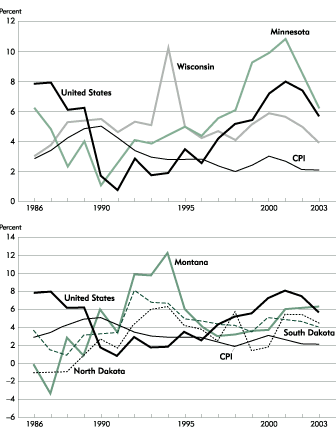Home prices rose significantly during the past few years as demand increased. Nationally, the average price for homes as measured by the House Price Index has increased well above the rate of inflation (percent change in the consumer price index) since 1996. The highest year-over-year increases for the third quarter were reached in 2001 at 8 percent and moderated to 5.6 percent in 2003. The House Price Index, published by the Office of Federal Housing Enterprise Oversight, tracks average house price changes in repeat sales or refinancings on the same single-family properties. (See map.)
Demand for homes grew due to relatively low interest rates, which reduce the total cost of purchasing a home, and increases in personal income, primarily during the strong economic growth of the 1990s. Despite increases in home prices, low interest rates and higher income levels have kept homes affordable overall.
The National Association of Realtors reported that affordability reached its most favorable level in 30 years during the first quarter of 2003, according to the organization's Housing Affordability Index, which measures affordability factors for all home buyers. The index decreased by the third quarter of 2003 but was still slightly better than year-ago levels.
In the district, house prices in Minnesota have outpaced the nation and other district states since 1996. Similar to the nation, prices in Minnesota moderated somewhat during 2002 and 2003. Montana is the only district state to show a slight gain in the rate of house price increases during the two-year period.
|
AVERAGE ANNUAL CHANGE
IN HOUSE PRICE INDEX 1986-2003
|
||||||||||||||||
Over a longer term, house prices in Wisconsin have averaged higher than the nation since 1986 with steady gains in home prices throughout the 1990s, but have seen slower growth than the nation during the past six years. Meanwhile, increases in house prices in North Dakota have on average grown just slower than the rate of inflation since 1986. During the same time frame, Montana and South Dakota house prices have grown faster than the rate of inflation but slower than the national average.
PERCENT CHANGE IN HOUSE PRICE INDEX*
AND CPI,** 1986-2003

* Third Quarter over Third Quarter
** Three-Year Moving Average
Sources: Office of Federal Housing Enterprise Oversight, Bureau of Labor Statistics




